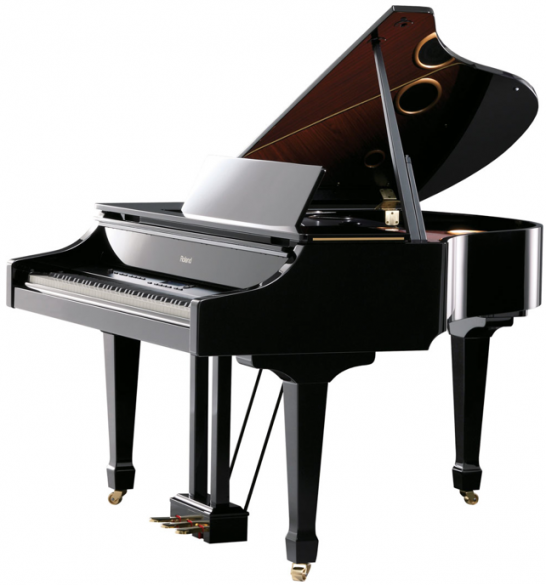
At the 2011 Winter NAMM Show, Roland U.S. introduce the new flagship of the V-Piano series, V-Piano Grand.
The new instrument combines V-Piano technology with a multi-channel sound system in a polished ebony grand piano cabinet, offering “unparalleled touch, playability, and sound for even the most discerning pianist”, according to the company.
At the heart of the V-Piano Grand is its component-based piano modeling technology, which recreates the complex interactions of the components inside an acoustic piano, resulting in “organic” grand-piano sound and performance.
Stepping up from the previous generation, the V-Piano Grand’s sound generator has been further improved, and new piano models have been added to the onboard library.
Features:
- Roland’s revolutionary V-Piano modeling technology in a grand cabinet.
- Onboard multi-channel sound system for true acoustic grand-piano sound.
- Deluxe PHA III Ivory Feel Keyboard with Escapement.
- Progressive Damper Action pedal for true acoustic grand-piano response.
- Elegant, traditional grand-piano cabinet design.
- New modeled pianos onboard fully optimized for the V-Piano Grand.

Wow, it's just like a – a – piano!
This is an idea tt could spread to other orchestral instruments. "Hi, I'm the new second oboe player. Where's my power supply socket?"
Wow, it's just like a – a – piano!
This is an idea that could spread to other orchestral instruments. "Hi, I'm the new second oboe player. Where's my power supply socket?"
I remember attending a conference in 1992 at the Peabody Hotel, Orlando. They had a Yamaha piano in the bar with electromechanical actuators on all of the keys and a digital memory. Every evening, a guy played the piano and it recorded his performance – to be repeated, with note-for-note perfection, the following afternoon, in his absence. With the keys and pedals operated invisibly. Kids used to wander up and try to touch the invisible player (if I put them up to it, of course).
I remember attending a conference in 1992 at the Peabody Hotel, Orlando. They had a Yamaha piano in the bar with electromechanical actuators on all of the keys and a digital memory. Every evening, a guy played the piano and it recorded his performance – to be repeated, with note-for-note perfection, the following afternoon, in his absence. With the keys and pedals operated invisibly. Kids used to wander up and try to touch the invisible player (if I put them up to it, of course).
This couldn't be that much fun.
I remember attending a conference in 1992 at the Peabody Hotel, Orlando. They had a Yamaha piano in the bar with electromechanical actuators on all of the keys and a digital memory. Every evening, a guy played the piano for a couple of hours and it recorded his performance – to be repeated, with note-for-note perfection, the following afternoon, in his absence. With the keys and pedals operated invisibly. Kids used to wander up and try to touch the invisible player (if I put them up to it, of course).
This couldn't be that much fun.
And now even YOU can own a digital piano as the same price as a real baby grand. Isn't technology wonderful?
This is madness.
THIS IS SYNTHTOPIA!!!!!!!!
:~)
Madness is the new sanity. Haven't you read the sanity clause?
Wait for it…
“sanity clause”
Havn’t heard that in a while! Marx my words.
Crazy expensive, yes, but I heard a performance on it and the sound is amazingly realistic. It’s built-in speakers filled a 40 60 foot room without need for other amplification and when I tried it myself, I found it very responsive and satisfying. So the u Kaye benefits are about it’s relative portability a its variety of voices. You can style it’s touch, tuning and tonality far more subtly than with other synths and it is a very elegant instrument to behold. Perhaps the first piano to deliver a believable performance for audiences, response for the player and relative portability for touring. And one crazy expensive ground-breaker.
Its a wonderful instrument. Roland is doing a great job inventing new things.